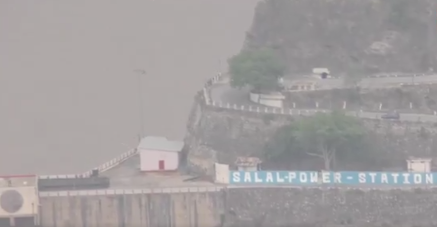Reasi, May 7, 2025 – India has sharply curtailed the flow of the Chenab River to Pakistan, opening just one gate of the Salal Dam in Reasi, Jammu and Kashmir, as a strategic response to heightened tensions following the suspension of the Indus Waters Treaty ( on April 23, 2025. The move, captured in a video circulating from Reasi, follows the Pahalgam terror attack that claimed 26 lives, which India attributes to Pakistan-backed militants, prompting a robust diplomatic offensive.
The Salal Dam, a 690 MW run-of-the-river hydropower project, had all gates closed earlier this week for desilting and reservoir refilling, reducing the Chenab’s downstream flow to a trickle. Visuals from Reasi and Akhnoor revealed an almost dry riverbed, with locals walking across areas typically submerged. On May 7, one gate was opened, partially restoring flow, but the restricted release continues to impact Pakistan’s Punjab, a vital agricultural hub reliant on the Chenab for irrigation.
This action mirrors earlier restrictions at the Baglihar Dam in Ramban, where gate closures slashed water flow by up to 90%, as reported by the National Hydroelectric Power Corporation . The advanced desilting, typically scheduled for August, aligns with India’s decision to suspend the IWT, a 1960 World Bank-brokered agreement granting Pakistan primary rights to the Chenab, Jhelum, and Indus rivers, while allowing India non-consumptive uses like hydropower. The suspension followed the Pahalgam attack, with Prime Minister Narendra Modi’s government vowing to maximise India’s water resources.
Jal Shakti Minister CR Patil declared that India would ensure “every drop” of Indus system water serves national interests, signaling plans to accelerate hydroelectric projects such as Pakal Dul, Kiru, Kwar, and Ratle on the Chenab, slated for completion by 2027-28. These projects aim to boost water storage and power generation, potentially reshaping cross-border water dynamics. India has also ceased data-sharing and flood warnings, further straining India-Pakistan relations.
Pakistan has decried the restrictions as a violation of international norms, with its Indus River System Authority reporting a 90% drop in Chenab flow, threatening Kharif season crops like paddy and maize. Farmers in Pakistan’s Punjab voiced fears of agricultural collapse, with one stating, “Without water, our fields will become a desert.” Pakistani officials warned that sustained blockages could escalate tensions, potentially constituting an “act of aggression.”
In Reasi, locals expressed support for India’s stance, citing the need for retribution post-Pahalgam. However, environmentalists raised alarms about ecological risks in the Chenab Valley, a seismically active region hosting over 70 hydroelectric projects. Abrupt flow changes could harm aquatic ecosystems and heighten flood risks if reservoirs are released suddenly.
These reactions, while reflective of public mood, remain unverified. The development coincides with Union Home Minister Amit Shah’s recent meeting with border state leaders, including those from Jammu and Kashmir, underscoring a coordinated strategy blending national security and resource management.
While the run-of-the-river nature of Salal and Baglihar limits long-term flow stoppage, India’s actions mark a bold escalation in cross-border tensions. The partial reopening of one gate at Salal signals a controlled but deliberate pressure tactic, reinforcing India’s resolve to leverage its water resources amid ongoing geopolitical frictions.



